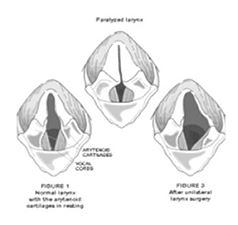Laryngeal paralysis symptoms
Laryngeal Paralysis usually has a subtle onset. A change in bark, slight exercise intolerance, or increased raspiness during breathing can be the only symptoms for an extended period (months). The dog may breathe loudly and with an increased effort, clear his throat frequently, gag, or vomit up white foam. Symptoms progress over time, and are exacerbated by heat, exercise and excitement. They can become severe enough to cause complete exercise intolerance, respiratory distress, and acute collapse.
Diagnosis of laryngeal paralysis
Although the symptoms and breathing pattern of laryngeal paralysis are fairly typical, definitive diagnosis requires examination of the larynx under sedation.
Treatment of laryngeal paralysis
Arytenoid lateralization, also called a laryngeal tie-back, is the procedure of choice for the correction of laryngeal paralysis. In this procedure, one side of the larynx is permanently opened via an incision made in the side of the neck. The half-open larynx allows sufficient air flow, which relieves the symptoms.
Risks or complications associated with the arytenoid lateralization procedure
There are risks and complications with any surgical procedure, particularly in geriatric patients. The most common potential complication is aspiration pneumonia. Approximately 10-20% of animals may have, or develop after surgery, aspiration pneumonia.
Postoperative management
Dogs need to adjust the way they swallow after this procedure since the architecture of their larynx has been changed. We therefore recommend feeding canned food that is made into meatballs until normal swallowing is assured. It is important to try and prevent attempts to bark in the first few weeks after surgery, to promote healing.
